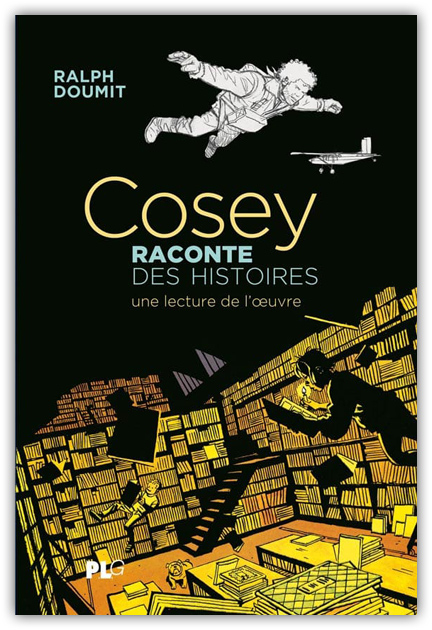
Ralph Doumit
PLG, 2022
The subtitle of this book is ‘Une lecture de l’oeuvre’ (A reading of the works), and that is a very appropriate term: the book is a very personal analysis of the works of Cosey by Ralph Doumit. He calls it himself a ‘little homage’.
Ralph Doumit was born in Beirut (Libanon) in 1985 – in the year that ‘Greyshore Island’ was published. From childhood onwards, he has been a huge fan of comics. He studied illustration and comics at the ‘Académie libanaise des Beaux-Arts’. At the same institute, he is now a professor, specialised (among others) in the history of illustration and comics. Ralph has been working on a book about Cosey for years – I have proofread an early version of a biographical chapter many years ago. I am happy the book has finally been published, for Ralph and for Cosey.
The book contains three types of chapters: a chapter that looks back on Cosey’s career, analysis of the works of Cosey and three chapters with interviews and writings of other Cosey- connaisseurs. All of it is written in a very clear, accessible style. When Doumit digs deep, his writing remains very accessible.
The book starts with a retrospective chapter: an overview of Cosey’s career and an overview of his albums. Of course, we read about his earliest influences, his formation as a graphic designer and his first steps towards a professional career as a comic artist. Noteworthy is also the part Cosey played in being some kind of pioneer of what was later called the graphic novel.
The analyses will probably be the most interesting part of this book for Cosey fans. Doumit has found some recurring themes in the works of Cosey. Some of them did actually surprise me (Why didn’t I think of this myself, I asked myself quite often), such as: many of Cosey’s characters are writers (even Mickey), and the combination of romantic encounters and water (I have myself written about bathing women, but Ralph found many more aquatic circumstances). Really excellent is his analysis of the ‘non-said’ in Cosey’s albums and the aspect of ‘time between the albums’.
Another very interesting part is Ralph’s analysis of some typical pages of Cosey. The analyses show that some of Cosey’s strongest pages are the ones without words. By discussing some Cosey pages, Ralph demonstrates convincingly the genius of the storytelling by Cosey.
Three other connaisseurs get the opportunity to talk about Cosey. The interview with Gilles Ciment (once the man behind the Cosey special of ‘Les Cahiers de la BD’) is excellent. In a few pages, Ciment knows to define and explain some of the intangible characteristics of the works of Cosey. The interview with photographer Jean-Pierre Grandjean shows some light on Cosey as a traveller and hunter for documentation. Comics artist Jean-Luc Cornette wrote an essay of how he looks at Cosey – to really estimate his writing I think I should know more of Cornette’s work and see how he is influenced by Cosey.
All in all, ‘Cosey raconte des histoires’ is a great little book. In 100 pages, Doumit succeeds in giving us new insights in the works of Cosey, and reading the book encouraged me to open the albums of Cosey once again.
